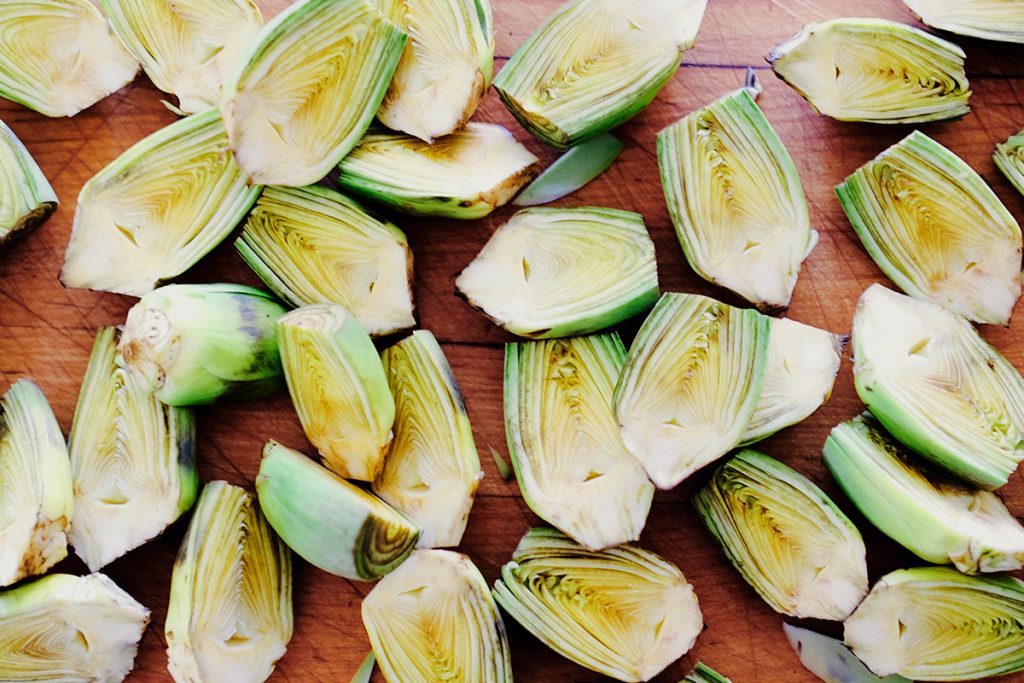
Both humble and exotic, the artichoke is a transporting food—to pick one up and turn it in our hands is to look back through time at one of the oldest cultivated foods with culinary roots back at least to the Greeks. Given the color and the ruggedness of the plant, it’s easy to imagine them growing in the scraggly soils of windblown islands beside the vast blue Mediterranean. A superfood and one of the healthiest things on earth to eat, artichokes are actually flower buds (as are capers), relatives of the thistle. Here is an excellent post on their distinguished history.
For me fresh artichokes bear a sweet sentimentality. They were a delicacy in my family; we’d prepare them in the most basic way, steamed and served whole with a side of mayonnaise for dipping the leaves and heart. Later in life, when I had to good fortune of being in Rome in the right season, carciofi alla giudia, the great deep-fried delicacy of the Eternal City, made a huge impression. Closer to home, I’ve always been grateful to eat one of Frank Ostini’s signature grilled artichokes at his restaurant, the Hitching Post II, in Buellton on California’s central coast. (Frank’s also an excellent winemaker.)
But of all the kinds of artichokes and their various preparations, the most irresistible for me is the baby artichoke. Unlike, say, “baby” carrots that are simply milled down from broken pieces of larger carrots, baby artichokes are harvested when tiny, only the length of a pinky finger. They’re mature, simply buds that didn’t grow larger. Their unique pleasure lies in the fact that they never formed that fibrous “choke” and thus are completely edible with a bit of trimming. You can just pop them whole into your mouth. Baby artichokes are highly nutritious, to boot, even showing higher levels of antioxidants than their bigger siblings.
Trimming the baby artichoke is easy. Just slice off the spiky tip with a sharp knife. Then peel away a few of the tough, outer leaves. I’m pretty ruthless in this–while it does significantly diminish the size of the already small vegetable, trimming down to the green, thin, inner leaves results in a tender morsel that is easily chewed. If you’re not going to cook them right away, float the little guys in a bowl of water spiked with the juice of half a lemon; it keeps them from premature browning.
Cooking is just as simple. A skillet is all you need. You can fry them in a half inch of oil with or without the garlic. I take an approach that uses less oil, cooking them flat side down in a skillet lightly coated with olive oil until they’ve browned. Then I add a bit of liquid—any sort of stock works well or vermouth or white wine and cover for a few minutes until the outer leaves are tender. Scoop them from the pan and into a bowl. When they’ve cooled, toss with maldon salt, a squeeze of lemon, and a chiffonade of fresh mint. They’re wonderful as an antipasto to munch on next to some olives, nuts, or salumi, to be washed down of course with an aperitif.
But what kind of aperitif? The bitterness in artichokes makes them palatable with classic Italian-style bitters like Campari or Cynar, which is flavored in part with artichokes. Mix these liqueurs over ice with soda water, and you’re in business. Of course, I also like the challenge of putting artichokes against wine, as they are the food world’s most notorious wine killer. This murderous bent is thanks to the presence of the compound cynarin, which Harold McGee notes, “apparently inhibits the sweet receptors on our taste bus, so when it’s swept off the tongue by the next bite, the receptors start up again, and we notice the contrast. Because they therefore distort the flavor of other foods, artichokes are thought to be an inappropriate accompaniment to fine wines.”
However, some people may not experience this. As Jane Adams Finn wrote in the Washington Post in a 2001 piece, “It seems that cynarin, unique to artichokes, can lend a sweet aftertaste to other foods and drinks. It also seems that the ability to taste this sweetness could be genetically based. Some notice the effect, others do not. Pass me the wine. I’ve never noticed a thing.”
I certainly have noticed the artichoke’s ability to warp a wine, but it’s easily gotten around. First, in my preparation, the addition of the mint seems to moderate cynarin’s effect. Somehow, it just keeps flavors steady and in line. Second, the wine must simply be tart, bone dry, crisp, and unoaked. Any sweetness from residual sugar, a high degree of fruitiness, or oak treatment will be seized by the artichoke and twisted into a dissonant flavor. Look to dry, prickly whites, sparkling wines, light reds, and roses that finish with a clean and brisk.
Here are a few excellent choices from the Source’s portfolio:

